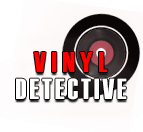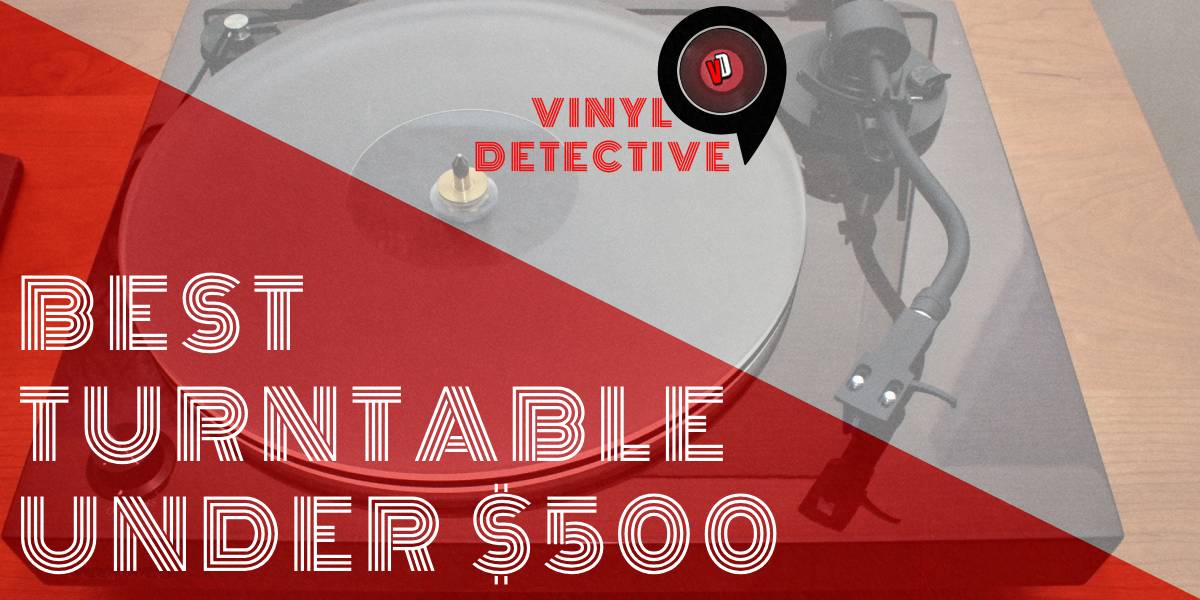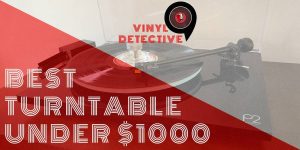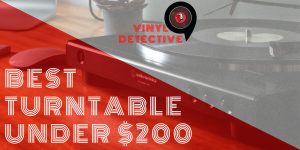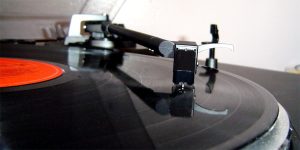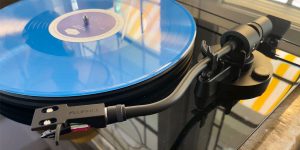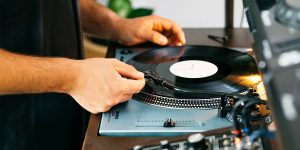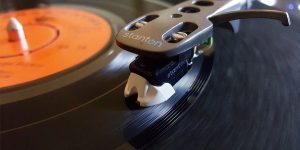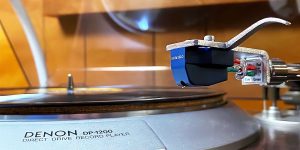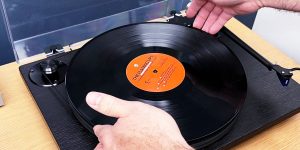When looking for the best turntable under $500, you can easily get confused by the variety of models on the market. Therefore, this review is intended for those who want to buy an inexpensive but optimal option. You will find in this article a fully automatic, working with Sonos or a multifunctional vinyl record player. It all depends only on your preferences. Taking into account that this category of modern turntables does not assume an audiophile level, I will consider turntables by a combination of sound, quality of construction (durability), and separate bonuses and chips that may not relate to vinyl directly but will diversify your audio system.
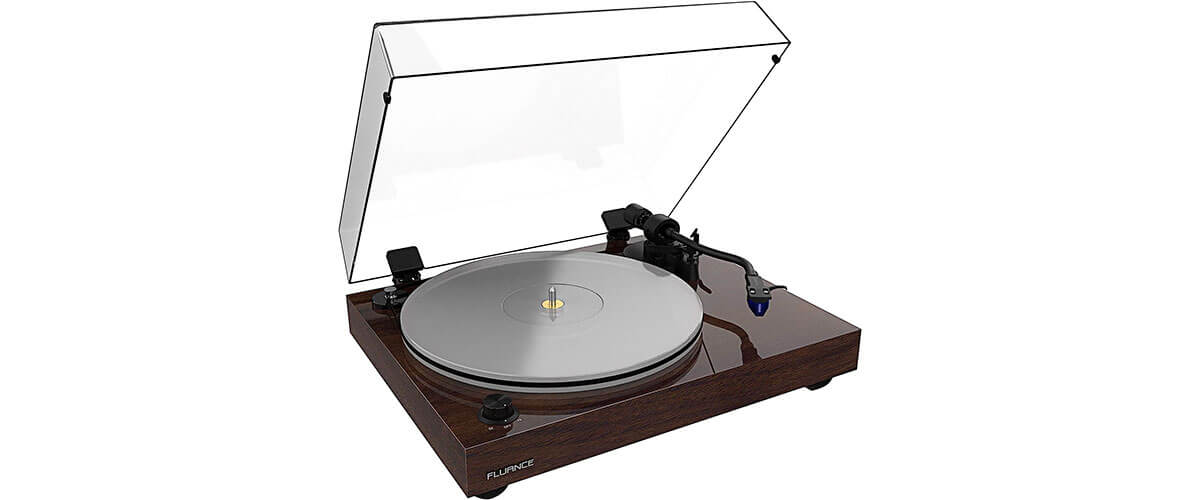
Turntables under $500 comparison table
| Name | Drive type | Operation type | Speeds | Phono Pre-Amp | Bluetooth | Review |
|---|---|---|---|---|---|---|
| Fluance RT85 best overall | belt | manual | 33 1/3, 45 RPM | yes | yes | Review |
| Audio-Technica AT-LP120XUSB-BK also great | direct | manual | 33 1/3, 45, 78 RPM | yes | no | Review |
| Denon DP-300F fully automatic | belt | fully automatic | 33 1/3, 45 RPM | yes | no | Review |
| Victrola Stream Onyx works with Sonos | belt | semi-automatic | 33 1/3, 45 RPM | yes | no | Review |
| Pro-Ject T1 minimalistic design | belt | manual | 33 1/3, 45 RPM | yes | yes | Review |
Best turntable under 500 dollars reviews
Fluance RT85 – best overall

The Fluance RT85 tops my chart because it looks as much like what should be called a vinyl turntable as possible. It doesn’t even have a built-in preamplifier because every vinyl connoisseur will tell you that an external phono stage is the better solution.
This turntable for $500 is made of good materials. The MDF case is quite heavy (16.76 lbs) and has three anti-resonance rubber feet. So, if you place the RT85 on a flat surface, you probably won’t have to worry about weighing it down. Plus, the acrylic platter adds quality (better than aluminum) and weight, but no slip mat is included. Not that this is a problem today, but when buying something of more or less quality in the budget category (well, close to mid-level), you are bound to get compromises. The glossy surface (several color variants) looks very nice, and the outside belt adds elegance and style, but when testing, I was armed with gloves because any touch leaves prints.
The Fluance RT85 can play records at 33 and 45 RPM speeds. That’s the standard for most inexpensive turntables. Its aluminum tonearm has an S-shape, widely considered the most suitable for extracting sounds from record tracks. But the declared Autostop function of the turntable works with varying success. If I understood correctly from testing other models of the brand and customer reviews – this is a “disease” of Fluance RT. In this regard, the tonearm design is not the most reliable; it looks unconvincing and makes me doubt its durability. If you compare this tonearm with the one installed on the Pro-Ject T1 from my list, the difference is noticeable. The latter tonearm is tight and doesn’t feel like I’m about to rip it off. So, for the RT85, I recommend handling it with extreme care.
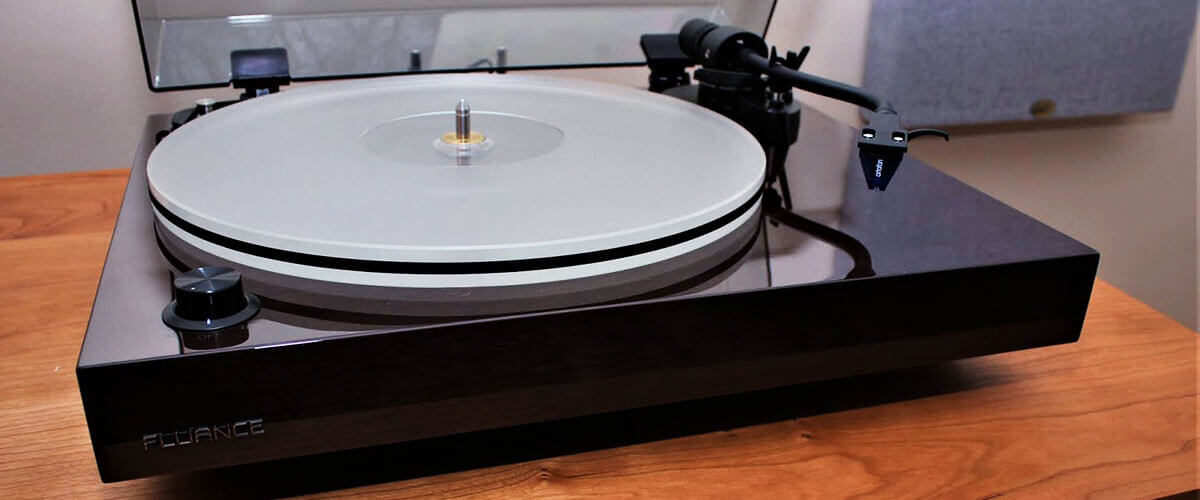
The turntable’s stylus is equipped with an Ortofon 2M Blue cartridge, considered an absolute leader among budget and medium segment users. Of course, Ortofon has more expensive variants, but replacing this one will cost you half the price of Fluance RT85. Anyway, I don’t think you’ll have to replace it anytime soon. It does its job very well, and overall, the model in question sounds wide, as if enveloping you with sound. The sound is clear, warm, and rich, and I didn’t encounter any lags, even at quite a high volume. The player lost a bit of detail for a more dynamic VAST record, but it sounds very good compared to the other models in my review.
Fluance RT85 is the best record player under $500 because it sounds richer and wider than the other models, even the ones in this rating. It’s really a vinyl player without the frills, but it will require you to buy additional equipment in the form of speakers and an external preamplifier.
The construction (except for the flimsy tonearm, which is nevertheless optimal for vinyl) is robust and provides anti-resonance, verified by lengthy testing. And even the gold-plated RCA connectors show that the manufacturer has paid attention to details for a long service life. And let’s talk about the Ortofon 2M Blue cartridge, which is half the price of this model. An excellent choice for many years if you are interested in good analog sound.
Key specs
- Drive type: belt.
- Operation type: manual.
- Speeds, RPM: 33 1/3, 45.
- Phono Pre-Amp: yes.
- Bluetooth: yes.
- USB: no.
- Aux input: no.
Pros
- The anti-resonance design (rather heavy MDF cabinet, rubber feet, and acrylic platter) does not require additional alignment manipulations during installation.
- Gold-plated RCA connectors.
- The most optimal S-shape tonearm.
- Ortofon 2M Blue cartridge costs half the price of the turntable and is very good in business.
- Extensive, deep, rich sound with the right selection of additional equipment.
Cons
- The Autostop function works intermittently, which can affect the longevity of the fragile tonearm.
Audio-Technica AT-LP120XUSB-BK – also great
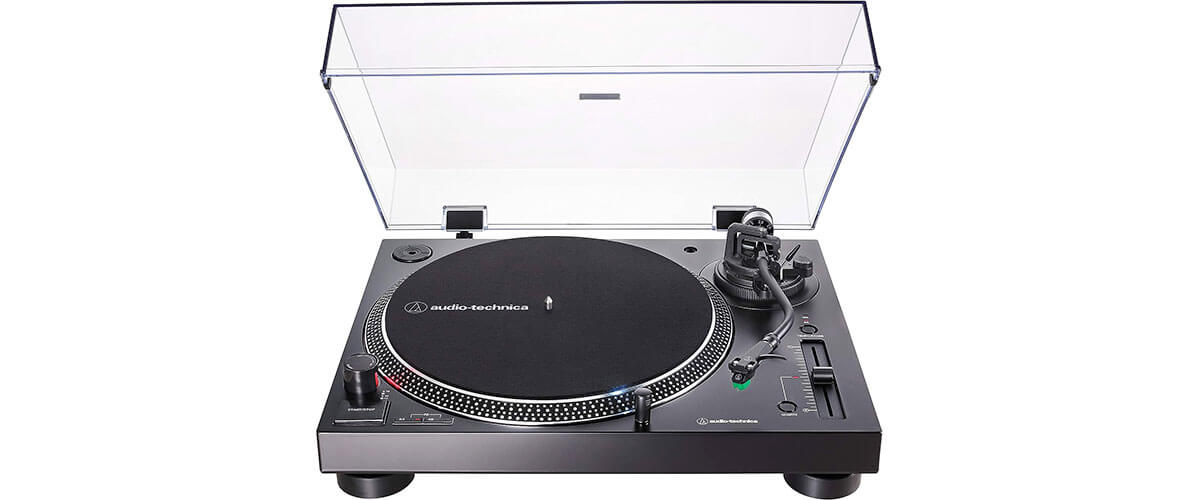
Also, a great, fully manual vinyl player for less than 500 dollars that looks like a toy version of a DJ deck is the Audio-Technica AT-LP120XUSB-BK. I can well imagine how happy a teenager with a passion for analog music might be to receive such a gift. This is the most inexpensive model on my chart, replacing the popular AT-LP120-USB that once gained popularity among users. Do not consider it as a professional turntable. For an absolutely acceptable price, you get not only the most reliable but also an interesting device with three speeds: 33,45, and 78 RPM.
The case and all the control parts are made of plastic. The turntable has normal for its category weight of 17.6 lbs, aluminum platter, and DC servo motor (Direct drive). The AT-LP120XUSB-BK, like the Fluance RT85, has an S-shaped tonearm equipped with a detachable headshell and a replaceable AT-VMN95E cartridge. This cartridge is very common among budget segment users; it’s easy to buy if it breaks. And the cartridge is inexpensive. Unlike the RT85 set, I found a felt mat here. But honestly, throw it away immediately or find some other use for it because while listening to a record, it just rolled off (I smiled at this point because when it comes to low budget, you always spend more in the end). Purchase a rubber one (I had one). Overall, the overall impression is plastic, plastic, and once again, plastic. But friends – AT-LP120XUSB-BK will not disappoint you for your money.
So, the built-in preamplifier is expected to be too simple. It is quiet and inexpressive, but the picture played with bright colors when I connected the turntable to an external amplifier. Even the dynamic Bee Gees sounded quite convincing.
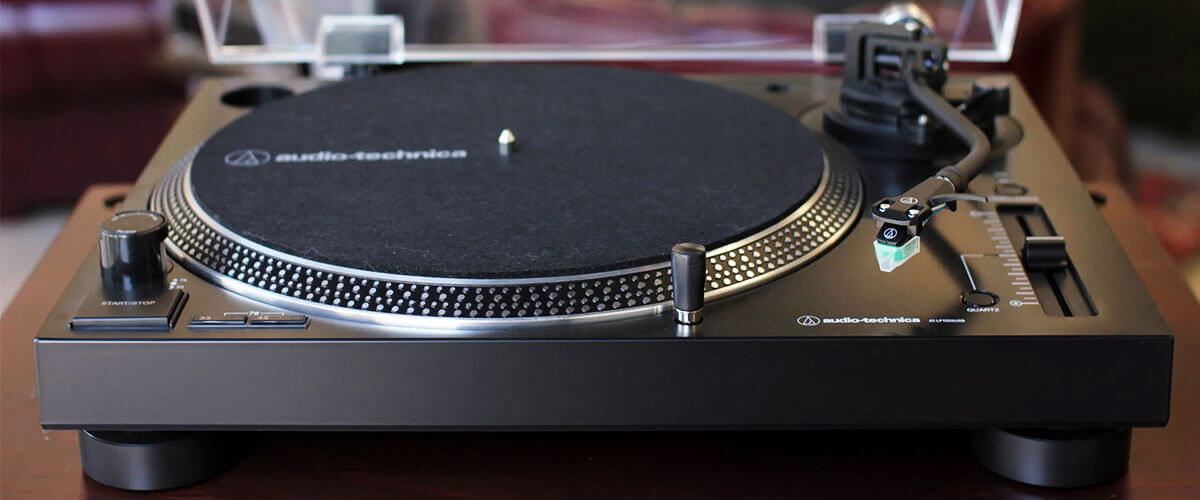
You must have noticed the magic letters USB in the model name. I’ll tell you right away that the better a turntable is, the fewer features it has (never a phono stage, no additional connectors, and “features” in the form of wireless functions and so on). But if we’re talking about something simple and affordable, then you’re not an audiophile, and you may want to record your favorite tracks on your PC (I don’t know why it’s necessary in today’s world, in the presence of a huge number of resources with streaming, but I have to describe all the options if they are stated).
Audio-Technica AT-LP120XUSB-BK can be singled out among vinyl turntables under five hundred dollars. It will be an excellent initial learning device for those who dream of understanding vinyl over time. Its sound can satisfy the unassuming listener, although, with the built-in preamplifier, it sounds a bit quiet. But if you spend on buying an external preamplifier and speakers, I may consider this model as behavioral for long-term use.
All controls are manual, and you can replace the removable popular AT-VMN95E cartridge. So pick records that aren’t too valuable, and you can even podge on this deck. In any case, learning how to handle manual control is important, and I see no reason not to do so with the AT-LP120XUSB-BK.
Key specs
- Drive type: direct.
- Operation type: manual.
- Speeds, RPM: 33 1/3, 45, 78.
- Phono Pre-Amp: yes.
- Bluetooth: no.
- USB: yes.
- Aux input: no.
Pros
- The fully manual controls will help you learn how to handle the turntable.
- The three spin speeds are 33, 45, and 78 RPM.
- You can DJ (but don’t get too deceived).
- The removable, inexpensive AT-VMN95E cartridge is quick and easy to replace.
Cons
- There’s a lot of plastic in the construction.
- The built-in preamplifier sounds quiet and loses detail.
Denon DP-300F – fully automatic
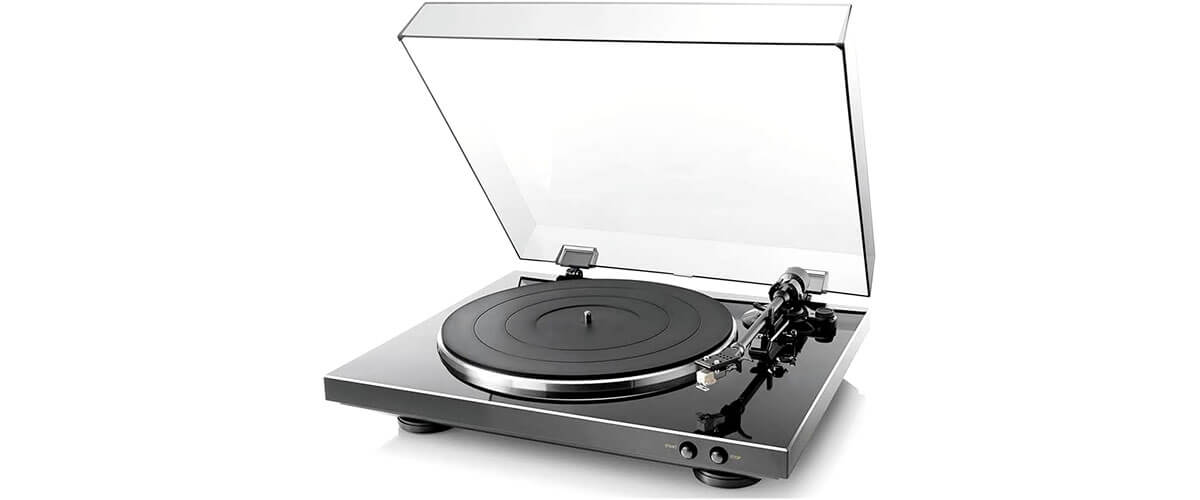
I can offer a fully automatic record player, Denon DP-300F, for those not interested in manual operating. Its price is somewhere between the price of Fluance RT85 and Audio-Technica AT-LP120XUSB-BK, and the turntable is a very attractive DC motor, belt-drive model with two playback speeds (33 and 45 RPM) and plug-and-play operation.
Yes, the DP-300F is very beautiful (for me). The glossy, smooth surface appeals to the eye, but I’m shocked by such designs because I imagine they require maintenance. Dust is vinyl’s first enemy, but the nice fact is that the dust cover can be closed while playing a record. I also always wear gloves when testing decks with this design. The case weighs 12 pounds because this beautiful chassis is made of plastic, and the feet are not adjustable. So the first time I turned it on, the turntable started literally bouncing around on the table I put it on. It bounces from the speakers’ sound or even when I walk by, so weigh the bottom first to hear what the Denon DP-300F sounds like.
This model, like the previous two, has an S-shaped tonearm. But the CN-6518’s stylus didn’t impress me. Well, let’s say I heard music, but analog sound usually evokes emotions, and in this case, even my favorite Fleetwood Mac record sounded flat, as if the needle was plucking only the surface of the song, not its depth. Replacing it with a more expensive cartridge changed the picture completely, even though the built-in phono stage leaves much to be desired (as they all do). If you want to really listen to vinyl, be sure to get an external preamplifier. Can you hear it? Absolutely. Don’t spare money, and you’ll be listening to even inexpensive turntables for years, without noise, hum, and with full-fledged sound.
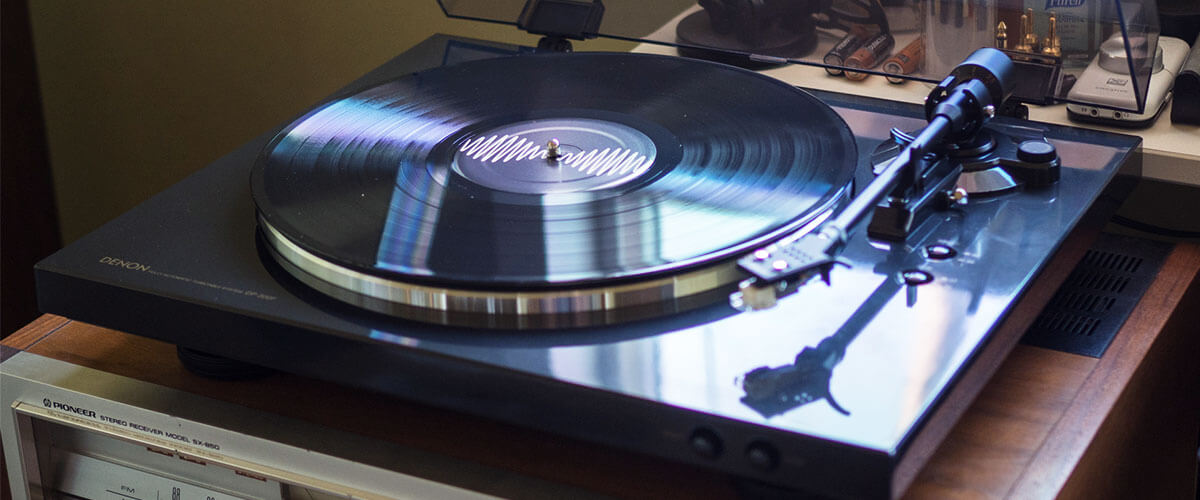
So, Denon DP-300F can become an analog for the more expensive Fluance RT85. At the same time, it is not as complicated as its cheaper Audio-Technica AT-LP120XUSB-BK. Connect it to your speakers, and it will turn itself off and remove the stylus from the record. What could be simpler than that? Its gorgeous design will appeal to many and fit into modern interiors, but stock up on a pair of gloves and always keep a dust cloth nearby. Gloss requires maintenance.
“Plug and play” is appealing to many users without pretensions. However, if you really want to listen to vinyl, pocket a tidy sum for an external amplifier, a better stylus, and a pair of good speakers. The warm, dynamic sound of the Denon suits analog sound just fine; for that alone, it can be awarded the title of best automatic turntable under $500. But with the built-in options, you’re unlikely to realize that.
Key specs
- Drive type: belt.
- Operation type: fully automatic.
- Speeds, RPM: 33 1/3, 45.
- Phono Pre-Amp: yes.
- Bluetooth: no.
- USB: no.
- Aux input: no.
Pros
- Fully automatic and works on a “turn on and play” basis.
- The attractive design will fit into any interior.
- The warm, dynamic sound from Denon is perfect for vinyl.
- The built-in phono stage and stylus can be replaced with better ones.
Cons
- It is very lightweight and bounces from any movement. Additional weighting is required.
- The glossy surface is beautiful but requires special care.
- The stylus offered in the kit leaves much to be desired. It does not extract music properly.
- The built-in phono stage is dull and quiet.
Victrola Stream Onyx – works with Sonos
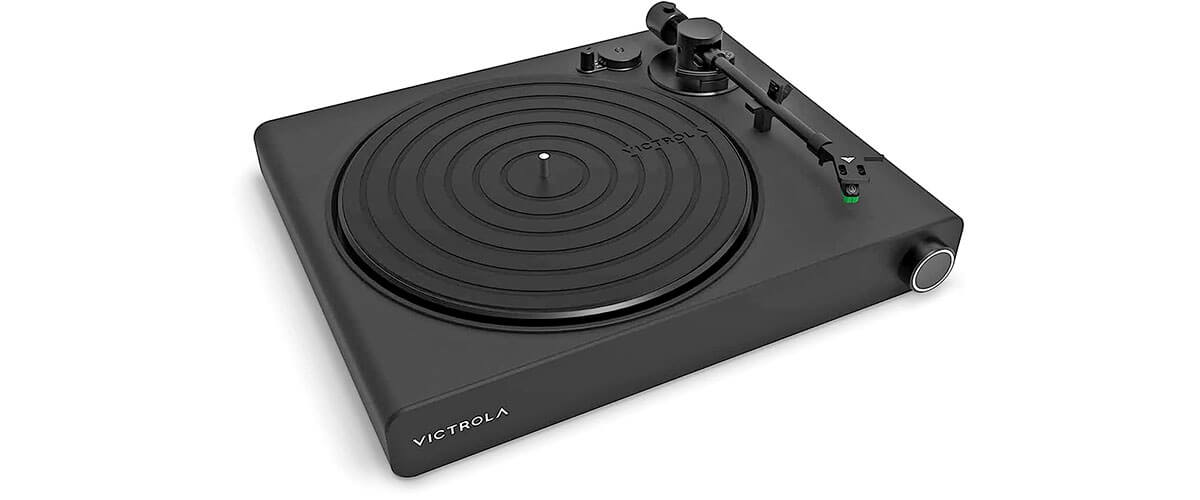
I can’t avoid the Victrola Stream Onyx model, although my personal opinion about the current trends of wireless analog music streaming (even though this expression itself is an oxymoron) is extremely negative. Still, I realize that many segment users are eager to access modern technologies. So, in front of me is a turntable compatible with Sonos.
To begin with, it’s worth saying that the Stream Onyx is made of MDF but covered in plastic, and to me, it doesn’t look stylish. I had the black version for testing; the silver one looks prettier in photos, but I haven’t seen it in person. But the chassis is equipped with silicone feet. They don’t really save from vibrations because the weight of 12.13 pounds doesn’t imply good anti-resonance (the same as with Denon DP-300F, jumping on the spot, as if the vinyl player decided to become the healthiest in the world and is constantly charging). However, I would like to point out the very smooth rotation of the die-cast aluminum platter. AC Motor with belt drive also showed quite stable, almost silent operation (I didn’t hear it while playing records, but if you start the turntable at idle, you can still hear it). You’ll like the silicone mat better than the felt one from Audio-Technica (haha, I can’t stop being sarcastic about it).
By standard, we have two spin speeds (33 and 45 RPM), a removable cartridge (AT-VM95E, similar to the one on the Audio-Technica AT-LP120XUSB-BK), and adjustments for anti-skating and stylus downforce. But the Victrola Stream Onyx has a straight tonearm. In general, considering the emphasis on vinyl digitization, this is quite insignificant.
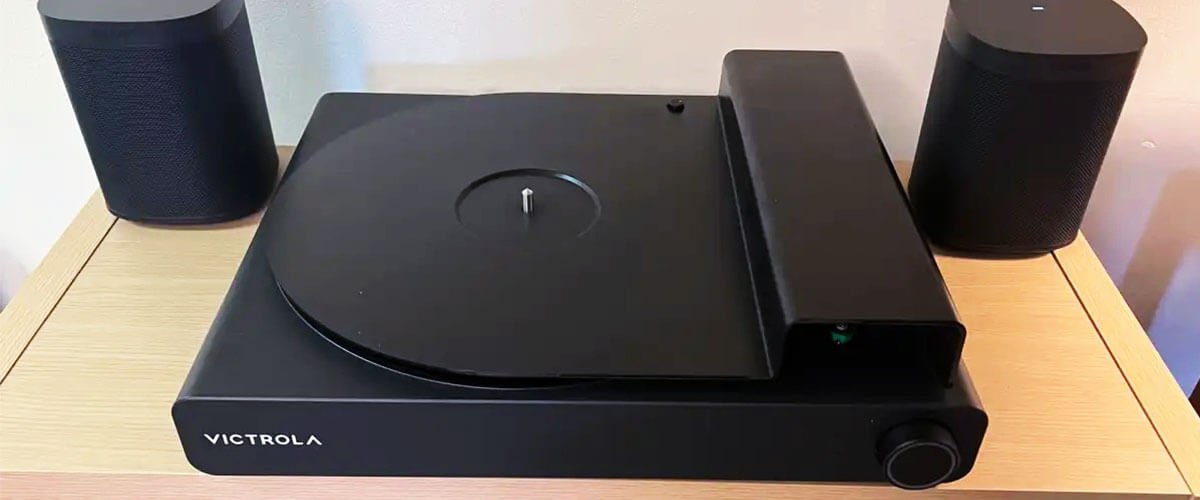
To be fair, you can refuse wireless connection with the speakers (via Wi-Fi) and connect normal wired speakers to RCA connectors. But then I don’t see the point of buying Victrola rather than Fluance RT85. So, I will continue, albeit without enthusiasm. The whole point is that vinyl is valued precisely for the authenticity of analog sound, and its digitization contributes to the loss of real studio sound, even when it comes to inexpensive turntables. But modern times, modern mores, and the result is vinyl on Sonos… Forgive my uninhibited skepticism.
Nevertheless, if you abstract away from my ranting, the system sounds good overall, and the signal is stable. I’m just going to assume it’s not a vinyl turntable but something similar to it. With regular speakers and an external preamp, the Stream Onyx sounds pretty good, too.
Victrola Stream Onyx is a modern device easily fitting into the 500-dollar record turntable category. But for analog sound connoisseurs, wireless music streaming should seem strange. So, I wouldn’t call it a full-fledged turntable, especially considering the poor anti-vibration protection, the presence of an extremely simple built-in phono stage, and a straight tonearm. All of this combined produces a quite ordinary turntable sound that can’t be compared to other models in the rating. If you asked me, I’d prefer the Fluance RT85. But times dictate their own rules, and this unit will surely have fans who prefer the idea of vinyl to vinyl itself.
Key specs
- Drive type: belt.
- Operation type: semi-automatic.
- Speeds, RPM: 33 1/3, 45.
- Phono Pre-Amp: yes.
- Bluetooth: no.
- USB: no.
- Aux input: no.
Pros
- Works with Sonos (I’m putting this on the plus side only because of its uniqueness). The connection is stable.
- It can be used with wired speakers and an external preamplifier.
- Noted the smooth operation of the die-cast aluminum platter.
Cons
- The plastic case looks cheap.
- Lightweight construction, poor anti-resonance.
- Analog sound does not involve digitization.
- The overall sound picture is lost to other rating participants.
Pro-Ject T1 – minimalistic design
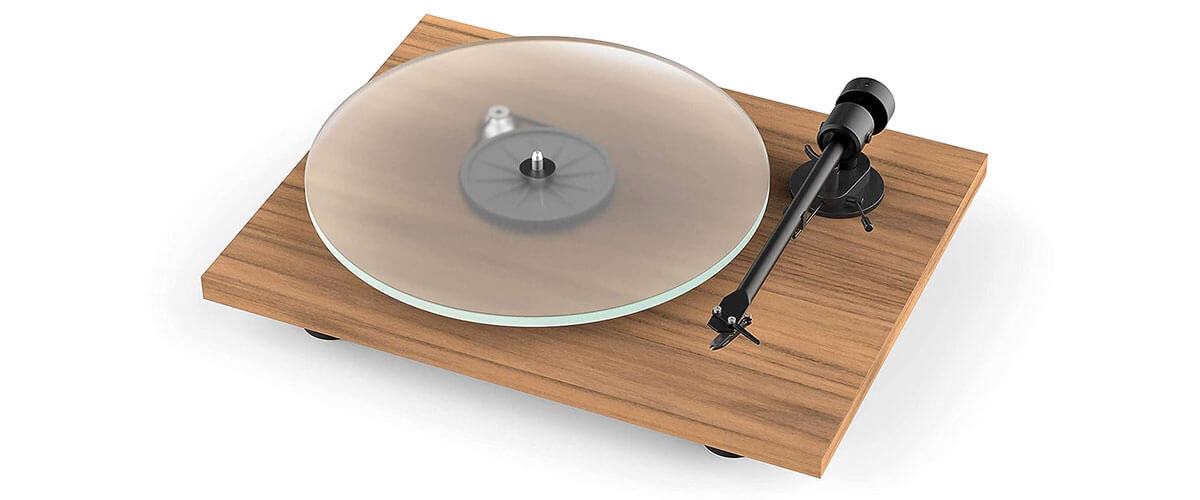
The Pro-Ject T1 record player could well take the first place in my review, but it loses to the Fluance RT85 in several respects. If we compare them briefly, both turntables are fully manual, play records at two speeds, 33 and 45 RPM, have no additional functions, and are models of companies that know much about vinyl.
The Pro-Ject T1 has the most minimalist design imaginable. The very thin CNC-machined plinth (no cavities), rubberized feet, and glass platter not only look mega-stylish, but at 8.4 pounds, it’s pretty stable against vibrations. Still, during testing, a delicate ear can pick up the resonance, so try to place the turntable away from the speakers on a surface level as possible (I used a level). By the way, it comes with a felt mat, but on the glass platter (which adds weight and stability of operation), it holds much better than Audio-Technica AT-LP120XUSB-BK (God, who came up with such a long name for the turntable?). From the minuses, we can note the presence of a built-in phono-corrector (Fluance RT85 does not have it, which indicates a more professional approach) and a straight tonearm (which loses to the S-shaped one). Still, its design is one piece, and therefore, it causes a feeling of reliable fixing (after all, here, semi-automatics are not supposed). The tonearm is tight, going up and down, but smooth, so I got it onto the record without jerkiness or unnecessary tension.
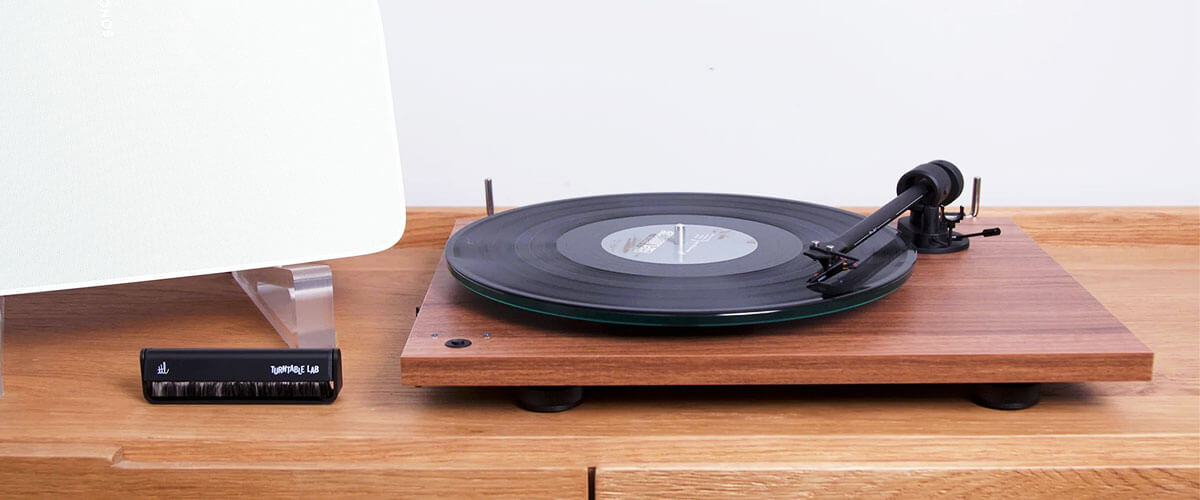
The Pro-Ject T1, like the Fluance RT85, has an Ortofon cartridge but the OM5e version. This version is significantly cheaper than the Ortofon 2M Blue, but you can replace it with another. While I understand the advantages of more expensive cartridges, it won’t matter much for most users when we’re looking at the fairly inexpensive segment of vinyl turntables. That is to say, all the above can tell you (well, or I do) that what you have in front of you is a good machine with longevity potential, all elements of which are aimed at extracting a very good record player sound. And indeed, in practice, the T1 makes a very good impression. And I am once again convinced that if a brand produces good equipment, it does not let itself rest even on its inexpensive models. And although the built-in preamplifier is nothing supernatural, most users will find it quite suitable. It saves you from the instant extra cost (unlike the Fluance RT85).
This model is perfect for people with good aesthetic and musical taste looking for a good turntable in a minimalistic design at a reasonable price. You won’t even need to buy an external amplifier at first, although, over time, I would recommend getting an external preamplifier. It will bring out the full potential of the T1, and it’s well worth it.
With no extra features, a removable mid-level Ortofon OM5e cartridge, fully manual, and solid components, I’d safely give the Pro-Ject T1 the top spot if not for the more professional Fluance RT85. All in all, this is one of the best turntables under $500.
Key specs
- Drive type: belt.
- Operation type: manual.
- Speeds, RPM: 33 1/3, 45.
- Phono Pre-Amp: yes.
- Bluetooth: yes.
- USB: no.
- Aux input: no.
Pros
- Minimalist design, but not bad anti-resonance in practice.
- Fully manual control speaks of the manufacturer’s professional approach.
- It has a good, detailed sound, even with a built-in preamplifier.
- The glass platter weighs down the design, rotates smoothly, and adheres well to the felt mat.
Cons
- The weight is less than the Fluance RT85, and vibrations can be heard. Minor ones, though.
- The built-in preamplifier is worse than the external preamplifier.
- The straight tonearm is worse than the S-shaped tonearm on the Fluance RT85.
- The Ortofon OM5e cartridge is more budget-friendly than the Ortofon 2M Blue in the selection leader, and you can’t install it. But a slightly more expensive one from the OM series still can.
